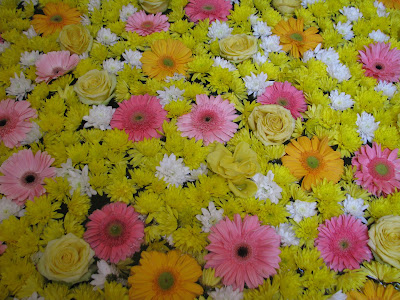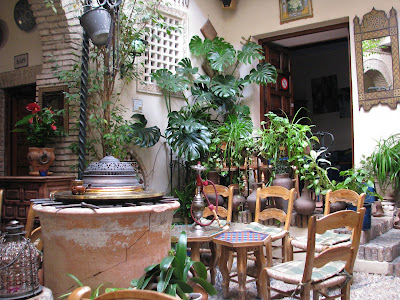For three centuries, Cordoba was the heart of the western Islamic empire as the medieval caliphate of the Moors. Any visitor interested in Moorish history will take a mecca to La Mezquita, the most awe-inspiring mosque built in Spain. In 929 AD, Abd ar-Rahman III adopted the title of "caliph" at a time when Cordoba was the largest, most prosperous city in Europe in terms of science, culture and scholarship, even outshining Byzantium and Baghdad (the capital of the eastern caliphate at the time).
Cordoba is a much smaller city than Seville, and is even moreso kissed by Arabic influence.
I traveled by train up the Guadalquiver River from Seville one hour, leaving Sharon behind to happily wander the streets of Seville for the day as I went on this solo mecca to Cordoba. My prime purpose: to experience La Mezquita (the mosque) for myself.
La Mezquita is in the center of the old walled-in city, surrounded by the Moorish and Jewish quarters. To get there, I wandered through the modern part of the city first.
A poster advertising Cordoba's own Semana Santa "celebration."
Cordoba and Seville: the cities of white pigeons!
A flamenco dress for sale in a shop window.

The entrance to the old city:
Wandering the narrow, pedestrian walkways of the old Moorish and Jewish quarters...
La Mezquita!
Entering the mosque's quarters through the Patio de los Naranjos, a classic Islamic ablutions court...
A blackbird guarding the door to the mosque...
And into the mosque, a forest of archways...
I couldn't stop saying, "Wow, this is beautiful!"
Alternating brick and stone in the arches created the red and white striped pattern.
A brief history of the mosque-now-cathedral of la Mezquita:
Abd ar-Rahman I, who had been bloodily expelled from the eastern caliphate of Islam in Damascus, was in control of Cordoba in the 8th century. He purchased this site from the Christians. At that time, it was the Cathedral of St. Vincent.
The Mezquita brochure was sure to tell me, "It is an historical fact that the San Vicente Basilica was destroyed during the Islamic period in order to build the subsequent Mosque. Originally it was the city's main church, a martyrs basilica from the 6th century that continued to be remembered and worshiped by the Christians, centuries after its disappearance." This Islamic "intervention" and "invasion" proceeded in the "demolition" of the church. But in 1236, King Ferdinand III "reconquered" Cordoba. This took place during "the Christian transformation." "It was a matter of recuperating a sacred space that had suffered the imposition of a faith that was foreign and distant from the Christian experience."
Geesh! A sacred space is a sacred space! It's designed for worshipping God! No need to get all defensive. I think "recycling" religious buildings was one of the most beautiful things I witnessed in Istanbul as well as in the Mesopotamian Valley of southeastern Turkey. I wish I could find a brochure from Istanbul to see how the Turkish Ministry of Culture phrased the back-n-forth of Christianity to Islam the Hagia Sofia experienced.
1293 marble columns
280 chandeliers
1445 lamps
The arches were like looking into a mirror. Misenabyme. The repetition created a vastness and a symmetry that evoked awe! Your eye was lost in pattern- unsure of what to focus on, as when looking in a kaleidoscope, but with some kind of unity emerging, as when looking at a magic eye poster. This sensation inspired a light upward feeling within me, an opening of the heart.
The center of La Mezquita was quite different though...
In 1523, this Renaissance cathedral coro was built, in opposition of the town council. For three centuries, the Christianizing dream fought to have this cathedral chapter, but they could not find a monarch to back them until 1523: Carlos V. However, upon completion of the coro, Carlos realized his mistake: "You have built what you and others might have built anywhere, but you have destroyed something that was unique in the world."
I couldn't have agreed more. In fact, I felt a distaste towards most of the Christian additions to the mosque. Seeming superficially fastened to the walls were depictions of Christ's crucifixion, his mother Mary's grief, saints suffering as martyrs- all the suffering others have done before us to help bear the load of the original sin commited by Adam and Eve. The two monotheisms' iconography did not match in this sacred space. There was an incongruity in the feelings they evoked in me, and I found myself wanting to revert back to the iconography of patterns- shapes, symmetry, repetition- complex and in effect, ultimately simple. I prefer to feel awed, humbled, opened by God within a sacred space. Not reminded of sin, pain, and suffering.
At least the Christian parts were mostly contained in the center. Returning to the outer walls, the original "caliphal" decoration surrounding the portals contained stunning latticework:
Islam's focus on geometric shapes, the horse-shoe shaped arch, and detailed latticework...
The mihrab, or prayer niche, of La Mezquita was used as a model for countless prayer niches in Spain and Northern Africa. It is crownded by a horseshoe shaped arch.
Back out into the city streets...
And towards the Roman Bridge and its Arab waterwheels...
Looking back at La Mezquita:
I wandered into the residential streets, out of the touristic area...
Already advertising for 2016!
For lunch I stopped at this restaurant to eat the local speciality: the tail of a bull. I always forget to take pictures of food. Sorry! Instead, I eat it!
I wandered into a courtyard selling local artisans' work.
Cordoba's old Jewish quarter:
The sinagoga (synogogue) is one of only three in Spain that survived the expulsion of the Jews in 1492. This one was built in 1316. It contained similar latticework to La Mezquita.
Next door is La Casa Andalusi, which attempts to recreate the atmosphere of the Moorish period. It was absolutely charming and made me nostalgic for Turkey!
A whirling dervish!
I finished off the day with a tea at this tea salon:
Quote of the day? From an Arab proverb I read on a poster at La Casa Andalusi, "To live is to love, most importantly to love life."





































































No comments:
Post a Comment